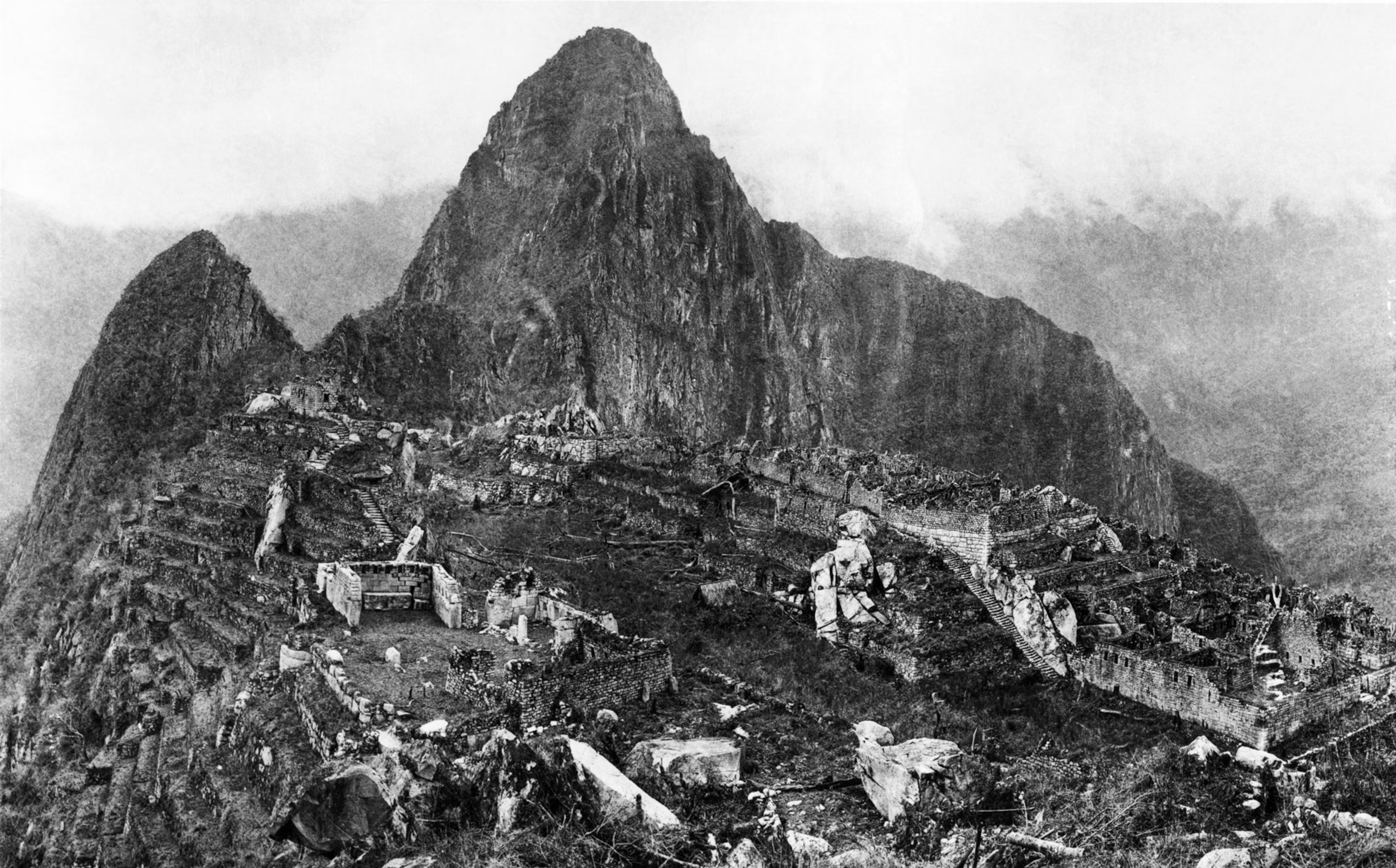 |
| Machu Picchu |
Q: In your last post you wrote about what you’d seen in the Colca Canyon and saw Condors. Your sister shared some details about Lake Titicaca. What have you been doing since then?
A: We have been to the Rainbow mountain and Machu Picchu.
Q: What was the most memorable part of your visit to Machu Picchu?
A: When we went to Machu Picchu, it was very cloudy. We could not see the city of the mountains. After a little while, the clouds cleared away and we were looking at the sacred city.

Q: Why does Machu Picchu exist? Can you tell us a bit more about its history and discovery?
A: It was a vacation home for the Emperor of the Incans. The site was chosen because it had stone for building and water for drinking. It was built 1450 and the Incans stayed there for 80 years and then left when the Spanish began conquering the Incans. Machu Picchu was rediscovered by an American professor named Hiram Bingham who was searching for a lost city of the Incans. He may have been searching for hidden treasure. A Peruvian named Agustin Lizarranga found the site before Mr. Bingham in 1902 but he did not make it famous. When it was discovered, the buildings had no roofs, the walls were falling down, and were covered by the jungle.
 |
| Machu Picchu - 1912 - Wikimedia Commons |
 |
| Machu Picchu - 2018 |
Q: You mentioned a rainbow mountain, can you tell me more about that?
A: The rainbow mountains were far away from Cusco. We had to get up at 4 in the morning to go there. We took a van part of the way to the mountain and then had to hike for about an hour to the mountain. We did not go all the way to the top of the mountain because it was steep and the altitude was very high. The mountaintop is more than 5000 meters above sealevel. It snowed while we were hiking. My dad went to the top and took pictures. The mountain’s real name is Vinicunca, but it is called the rainbow because it has lots of different coloured rocks and sand. The colours come from the minerals in the rock. Yellow is sulfur, red is iron, and green is chlorine. After seeing the mountain we walked back to the van. I accidentally left my sweater where we had lunch, but the tour guide picked it up for us and I got it back after we went to Machu Picchu.
 |
| Vinicunca - The Rainbow Mountain |
 |
| Its cold above 4500 meters! |
Q: What are your plans for the next part of your trip?
A: Right now we are in Lima, tomorrow we fly home, I am really excited to be back at Maple. I miss Maple, but we have to get up at 3 in the morning for our plane. I am grumpy when I wake up early so tomorrow I will probably be grumpy and I will probably get yelled at. But at least we’ll be heading home.


![DSC_1055[1] DSC_1055[1]](https://blogger.googleusercontent.com/img/b/R29vZ2xl/AVvXsEh_JTRpj1MGen3pVtZutlNiiMk1VdeKxXv8o7tQ939KAN14jNUDC72oBYJQl8G3ft2A0qP9KSyC-4fHrcjFRCbve5Bb5ms9Pr6LgJ20rtyCzhNaqhKcVyJjOAqaS8rZHFD5ULx7WQ6EoSs/?imgmax=800)
![DSC_0003[1] DSC_0003[1]](https://blogger.googleusercontent.com/img/b/R29vZ2xl/AVvXsEjuoWFyyUDPqkG8vkCHgsuA3jYIln1Ca2DwyELTCp4rJXX9J8p8mWAJt02hufygKc4Yf0Rn2ysgp_Lb4eJUNsvscLUZCNbjKg689lm8GDjCHA_v7qbzNWTuZ77QYYMHC5Mmaaibtwbu6nE/?imgmax=800)
![DSC_0016[1] DSC_0016[1]](https://blogger.googleusercontent.com/img/b/R29vZ2xl/AVvXsEh-byHzbJtjTTlFBOR1S4pn1lJj0xbOh8JFznNyCW7iK87oaSkBu__1GMlrXMTKQygJl6P_oXQRntZeNi5onDckK61PykU2adYhgco5PR_XIckSQEytUiW4aA9U6AHWp8saDsPo1CboR20/?imgmax=800)
![DSC_0067[1] DSC_0067[1]](https://blogger.googleusercontent.com/img/b/R29vZ2xl/AVvXsEhRC3NN2r63dJYUX5VxTP6WSJGoG7oDEFmGupVVQkiK3QSSx2igkYjEEy9kvxBMpKniivuAjwtnTkQmWANEMzcQG8LVQZdNAa2byhPIBCE87Ytv4YpunrOfhYkazPF2UX3WUudi2k3cCQE/?imgmax=800)
![DSC_0077[1] DSC_0077[1]](https://blogger.googleusercontent.com/img/b/R29vZ2xl/AVvXsEjiv4vN-tx4JFiGlO9EAB_3M3jK_n2-BZ1OogzAngVbKCZB7e2ld2ZR80QQ-hnhs-_4_nILfaLQx86GUPUGUaiKMIgUO7YZWX59A-eDLm7zl8GIl_scMulMbOG2aiFdMpfY56SA7qq01Vc/?imgmax=800)
![DSC_0082[1] DSC_0082[1]](https://blogger.googleusercontent.com/img/b/R29vZ2xl/AVvXsEiWDgVYhmHycEBf2_HCDGhsXt8YVE2agUhRIpQJSfP5SRMpBwLXIZtSmeEb995noSVVQROaW1pxJlEdtMsmVSY46kK0B8wvjdw0t6v14dCr2yntcsHYKb9zPBFOJW_Jfpws6KIO4itEvvg/?imgmax=800)
![DSC_0115[1] DSC_0115[1]](https://blogger.googleusercontent.com/img/b/R29vZ2xl/AVvXsEgiwTaCvLkJb_ZQYH44190OYVGLj9SgPfFdXUoo3JnGI61-nPa3hdGr_kHEvcAuUo6SHvx4A_GIr3_Hcd2Vj1mmJWHlQ9oQodwdgPwtzuZvRsiys4zySAbGNKkrN-bGBr4SpoMzAp0ywo4/?imgmax=800)
![DSC_0123[1] DSC_0123[1]](https://blogger.googleusercontent.com/img/b/R29vZ2xl/AVvXsEiOKb2YqNHhEXxt9y8GFPHdxTnLEX02wLbJJE5RZ9IjMZQ2p-pfL4RqewO6lpY8MIg9xHkkRATPARRMKezUIy0b-Y-BwWteRPzHlm3jQxuCs8NcM6SgP7fw49l-eVDzZTVSaqTST7V7ugk/?imgmax=800)
![DSC_0097[1] DSC_0097[1]](https://blogger.googleusercontent.com/img/b/R29vZ2xl/AVvXsEgE-Ly1FrneezrbS0p10bQob-4YoplsuFwEuy4wdBPsLm0XUQ8W_SCy439y4In-y75hSwk4bIvyzTpWQ_58nItdx8sneY1ldu829cys_6sghxtl2qrLQn5o90Z8SB5Wwa_SyvHKls2deZg/?imgmax=800)
![DSC_1010[1] DSC_1010[1]](https://blogger.googleusercontent.com/img/b/R29vZ2xl/AVvXsEiQTJRj8q8SEX3AJsNjeK3Wp-FZD-r5FWK_kFL4uigUgabPwYjuZjGFxJ0CyybuyOfF7no7lp4MEEPwPptsIQcjt0i1key5D0-qq_2tLFQyT7_nzaml1xwzf3YH67CNnsP4P5UlNq4VKDY/?imgmax=800)
![DSC_0762[1] DSC_0762[1]](https://blogger.googleusercontent.com/img/b/R29vZ2xl/AVvXsEiuZPm0Esm5S2U3H3XQgWvl9qWZ9vZ_zdXFa0PuCJn0t8lwR5ybbKVPnHiclVcPvbWmW1K_fv7DfCahcWyDDXCjbOW32RX6DAyqnn9zYVFK2b37dLnXc37lVgs43QAfF88U8YsEJmKXjzY/?imgmax=800)
![DSC_0776[1] DSC_0776[1]](https://blogger.googleusercontent.com/img/b/R29vZ2xl/AVvXsEhTr9yUlifjBxBWU91flfjZWALFB447pwwtC-JCY2NztPotoW-PwD6rKHARE1CuT6Np3elkzmVjCr4v1r-CPJC7APJfLSHW8AoxR1SJMYmU8NCBa8ECKrQtWh_x-CI3BvY48F0eDBIp1Kc/?imgmax=800)

![DSC_1009[1] DSC_1009[1]](https://blogger.googleusercontent.com/img/b/R29vZ2xl/AVvXsEj2Wgb3ntx9QWsQxnRvlRxtsr1RFfzfHbk_kdSW8ftwgbfrr-ekMPZxBcSq2JU2FsbJJUYLZ-7UEeW4LNpTeByYQjtIKHW4aWbSBN15iSRYeRBY857-18qGkW1L7jHUlUq5fC1vHCwWHGs/?imgmax=800)
![DSC_1032[1] DSC_1032[1]](https://blogger.googleusercontent.com/img/b/R29vZ2xl/AVvXsEjSocIixPRgvIuI3T_s7_SMllrVDljnK-W4R_vlubwWNmCwUNqVRoGAOGuMLKFP2sUQ_KmuVTaXFM1yj60AfkQYIucBJhXMr_YuYlDtBqSWyDE82lQMtK2llGVGbtxKEzbJgihypMMTzsU/?imgmax=800)
![DSC_0817[1] DSC_0817[1]](https://blogger.googleusercontent.com/img/b/R29vZ2xl/AVvXsEjaxVN3lAaWB1nl5dgxLRG6T7yxGPzXHHMQMxDwFWa0uQ7cteNPhAhf2qpj2mlaBoT7IFDHA218rTS_B6cC7H3SflnWTYrc79vE8NoYfarLTuahN4Uiqs73eTBabNh_tdCh_O9Nq9OBuCE/?imgmax=800)






